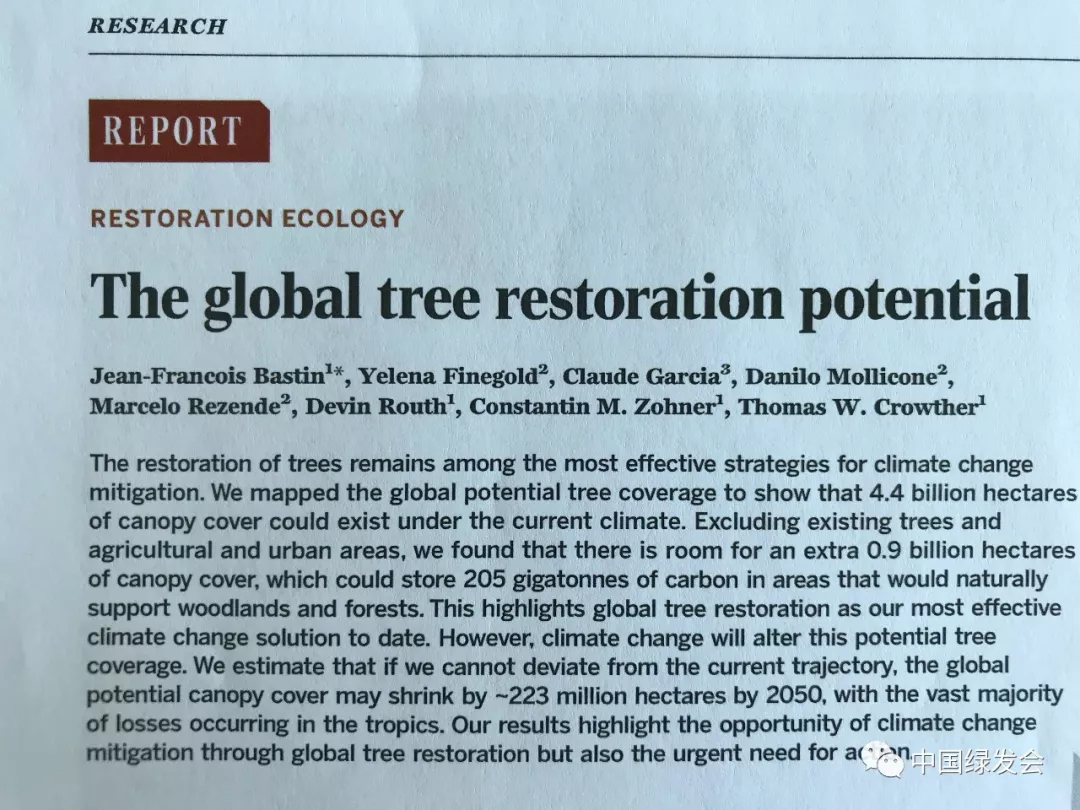- 收入总额:27103501.49元
- 支出总额:23122739.73元
- 爱心人次:2242次
编者按:近日,到访的FAO助理总干事Rene Castro博士向中国绿发会介绍了他们上周五已发表在《科学》杂志上的一篇研究,主题是“全球树木恢复潜力”。现将有关报道翻译发布如下。
按/Linda 译者/李雪 编/Angel

上图:FAO负责生物多样性和森林等领域的Rene Castro博士与绿会小伙伴分享的材料。该文已发布于Science。
New study: The global tree restoration potential
最新研究:全球树木恢复潜力
Did you know:The restoration of trees remains among the most effective strategies for climate change mitigation. The authors mapped the global potential tree coverage to show that 4.4 billion hectares of canopy cover could exist under the current climate. Excluding existing trees and agricultural and urban areas, they found that there is room for an extra 0.9 billion hectares of canopy cover, which could store 205 gigatonnes of carbon in areas that would naturally support woodlands and forests.
你知道吗?树木恢复仍然是缓解气候变化最有效的策略之一。作者绘制了全球潜在的树木覆盖图,以表明在当前气候下,可能存在44亿公顷的树冠覆盖。除了现有的林区,以及农业和城市地区,他们发现有额外的9亿公顷的树冠覆盖空间,这可以在自然支持的林地和森林地区储存205千兆吨的碳。
This highlights global tree restoration as our most effective climate change solution to date. However, climate change will alter this potential tree coverage. The authors estimate that if we cannot deviate from the current trajectory, the global potential canopy cover may shrink by ~223 million hectares by 2050, with the vast majority of losses occurring in the tropics. The results highlight the opportunity of climate change mitigation through global tree restoration but also the urgent need for action. ( abstract from the study published in Science ,Vol 365, Issue 6448 05 July 2019, see page 76; see also p. 24)
这突显出全球树木恢复是迄今为止最有效的气候变化解决方案。然而,气候变化将改变这种潜在的树木覆盖率。作者估计,如果我们不能脱离当前的轨道,到2050年,全球潜在的林冠覆盖面积可能会缩小约2.23亿公顷,其中绝大多数损失发生在热带地区。研究结果强调了可以通过全球树木恢复的方法来缓解气候变化,同时也迫切需要采取行动。(摘自《科学》,第365卷,第6448期,2019年7月5日,见第76页;另见第24页)
Many countries already have ambitious goals to plant trees. In Africa, a group of countries have pledged to restore 100 million hectares of forest. In Latin America, countries plan to restore another 20 million hectares. China deployed thousands of soldiers last year to plant trees covering an area roughly the size of Ireland (though that project planted single species, resulting in something that’s more like a tree farm than a real forest). But the new study found that 43% of the countries in the Bonn Challenge, a global effort to restore 350 million hectares of land by 2030, have only committed to restoring half of the land that could be restored.
许多国家已经有了种植树木的宏伟目标。在非洲,一些国家承诺恢复1亿公顷的森林。在拉丁美洲,各国计划再恢复2000万公顷的森林。去年,中国部署了数千名士兵去种植面积大致相当于爱尔兰国土面积的树木(尽管该项目种植了单一树种,结果导致更像是一个林场,而不是真正的森林)。但这项新的研究发现,在波恩挑战(全球努力到2030年恢复3.5亿公顷的林地)中,43%的国家只承诺恢复一半林地(在可以恢复的林地中)。
The new maps will help countries better plan where to plant trees, and what kinds of trees to plant. The interactive version of the data includes suggested species for some areas. As new trees are planted, the next step is equally difficult—helping the seedlings survive and giving communities nearby a reason to keep trees standing rather than eventually chopping them down. Even a startup that is planting trees by drone recognizes that it needs to work closely with local communities for the projects to succeed. “It’s not about planting, it’s about a restoration roadmap where planting is only a little part of it,” says Stolle.
新的地图将帮助各国更好地规划在哪里种植树木,以及种植什么样的树木。这些数据的交互版本包括了一些地区建议的物种。随着新树的种植,下一步同样困难——帮助幼苗存活,并给附近的社区一个理由,让树木一直存在,而不是最终砍倒它们。即使是一家“无人机植树”的初创企业也认识到,它需要与当地社区密切合作,才能使项目取得成功。“这和种植无关,而是与恢复路线图有关,种植只是其中的一小部分,”施托勒说。
On this new global map, huge swaths of land are dotted in green pixels. These are the areas that could potentially be recovered with forests that have disappeared, according to a new study—and in total, could help capture as much as two-thirds of the carbon that humans have pumped into the atmosphere since the industrial revolution.
在这个新的全球地图上,大片的土地用绿色的点标注。根据一项新的研究,这些地区可以用森林去恢复,总的来说,有助于吸收自工业革命以来人类向大气中排放的多达三分之二的碳。
Planting trees is far from the only thing that needs to happen to fight climate change. But the study makes clear exactly how much it can help. “Our research shows that it should really be considered to be a top solution that must be prioritized,” says Tom Crowther, a professor of global ecosystem ecology at ETH Zurich and one of the authors of the paper.( Source : Billions of new trees could help stop climate change: Here’s how we get them. A new study found that a massive reforestation effort could be a huge weapon in the climate fight. So where do we put all the trees?)
植树远非是对抗气候变化唯一需要做的事。但这项研究清晰地表明了它能起到多大的作用。“我们的研究表明,这真的应该被视为一个优先考虑的顶级解决方案,”苏黎世联邦理工学院全球生态系统生态学教授、该论文作者之一汤姆·克劳瑟(Tom Crowther)说。(资料来源:数十亿棵新树可以帮助阻止气候变化:以下是我们如何采用的方法。一项新的研究发现,大规模的重新造林可能是气候变化斗争中的一个强有力的武器。那么我们把所有的树木都种在哪里呢?)
How trees could save the climate. A tool on the Crowther Lab website (https://www.crowtherlab.com/maps-2/) enables users to look at any point on the globe, and find out how many trees could grow there and how much carbon they would store. It also offers lists of forest restoration organisations. The Crowther Lab will also be present at this year's Scientifica (web-site available in German only: https://www.scientifica.ch/) to show the new tool to visitors.
树木如何拯救气候?克劳瑟实验室网站(https://www.crowther lab.com/maps-2/)上的一个工具使用户可以查看地球上的任何一个点,并了解在那里可以种植多少棵树以及它们可以储存多少碳。它还提供了森林恢复组织的列表。克劳瑟实验室也将在今年的Scientifica(网站仅提供德语版本:https://www.scientifica.ch/)向访客展示新工具。
The Crowther Lab uses nature as a solution to: 1) better allocate resources -- identifying those re-gions which, if restored appropriately, could have the biggest climate impact; 2) set realistic goals -- with measurable targets to maximise the impact of restoration projects; and 3) monitor progress -- to evaluate whether targets are being achieved over time, and take corrective action if necessary.( Source ScienceDaily)
克劳瑟实验室使用自然作为解决方案:1)更好地分配资源——确定那些如果适当恢复,可能对气候影响最大的区域;2)设定切合实际的目标——制定可测量的目标,以最大限度地提高恢复项目的影响;3)监测项目进展——评估目标是否随着时间的推移而实现,必要时需采取纠正措施。(来源:科学日报)
原文链接:
https://knowledge.unccd.int/publications/new-study-global-tree-restoration-potential


